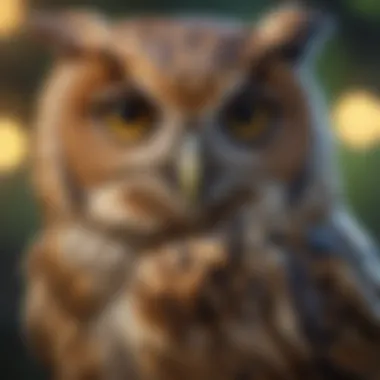Discovering Myself Through Animal Traits


Nature Topic Overview
In this article, we will explore how animals mirror human traits, fostering reflection on our own behaviors and feelings. By engaging with the animal kingdom, we can better understand our place within it and the intricate web of nature surrounding us.
Fun Facts and Trivia
- Did you know that octopuses have three hearts? This fascinating creature can teach us about resilience and adaptability.
- A group of flamingos is called a flamboyance. Their social nature may connect with how some children prefer teamwork.
These quirky facts not only captivate young minds but also encourage them to learn more about animals. Consider interactive elements such as coloring pages or matching games depicting various animals and their traits.
Wildlife Explorations
Uncovering Species
Animals can embody various human traits. For instance, lions are often viewed as symbols of courage due to their strong presence in the wild. In contrast, dolphins exhibit intelligence and playfulness, which may resonate with children who enjoy sports and games.
Habitats and Adaptations
Delving into different habitats, such as jungles, oceans, or deserts, reveals how animals adapt to survive. For example:
- Tigers excel in dense forests with their camouflage.
- Camels thrive in arid deserts with their ability to conserve water.
Quizzes or puzzles could enrich learning experiences, encouraging children to match animals with their habitats and behaviors.
Environmental Awareness
Recognizing the importance of conservation is crucial. Every animal plays a role in their ecosystem, affecting the balance of nature. Children can understand this by observing how different species are interconnected.
How to Help
Simple actions can create a significant impact. Encourage children to:
- Reduce plastic usage by using reusable bags.
- Plant flowers to attract local pollinators like bees and butterflies.
- Participate in local clean-up days at parks or beaches.
DIY Nature Activities
Hands-on activities deepen appreciation for nature. Here are some suggestions:
- Animal Masks: Guide children through creating masks of their favorite animals, constructing them with paper plates and colors.
- Nature Journals: Encourage kids to document their observations of animals or plants in their surroundings, drawing sketches or writing notes.
- Outdoor Exploration: Organize nature walks or scavenger hunts to identify different species and their habits.
By engaging in these activities, children can connect with the ideas presented throughout the article, enhancing their understanding of both themselves and the natural world.
"Animals are more than their habitats; they reflect characteristics we can see in ourselves."
Through this journey, inspire young minds to embrace their unique traits while developing respect for the intricate beauty of the animal kingdom. Each discovery not only adds to their knowledge but empowers them to see themselves in the diverse tapestry of life.
Understanding Animal Traits
Understanding animal traits is vital for grasping how our personal characteristics may align with those of different animals. This exploration allows us to see the similarities and differences in behavior, instincts, and social interactions. Realizing these traits provides insight into our own behaviors and thought processes. It encourages us to connect with nature and recognize the diverse forms of life that share our world.
When we consider animal traits, we gain a deeper appreciation for the various life forms around us. Animals exhibit unique traits based on their environments and survival needs. Learning about these traits can help us understand essential concepts like adaptation and the balance of ecosystems. The benefits of this knowledge extend to various aspects of life, including education and personal development. By observing how animals function in their habitats, we can reflect on our own attributes and how we interact with others.
Another crucial aspect of understanding animal traits is their influence on human behavior and culture. Different cultures assign specific meanings and values to animals, which can affect how individuals see themselves and their role within society. By exploring these traits, we can uncover symbolism that resonates with our unique identities.
"Understanding animal traits is about seeing reflections of ourselves in the diverse animal kingdom and learning from them."
In summary, studying animal traits enriches our knowledge and helps us make connections between ourselves and the world. It promotes discussion and self-discovery, ultimately enabling us to engage more meaningfully with our surroundings.
Personal Reflection and Identification
Personal reflection and identification play a crucial role in the exploration of our connection with animals. This section encourages readers to think deeply about their traits, feelings, and choices in relation to different animals. Understanding our similarities with certain species can help foster a sense of self-awareness. It can also provide a proxy for understanding our behaviors, preferences, and how we relate to the world around us. By reviewing personal qualities and matching them with animal traits, we engage in a process that sharpens both introspection and appreciation of animal life.
Connecting Traits to Animals
Different animals exhibit unique characteristics that often mirror human qualities. For instance, the loyalty of dogs can reflect our capacity for friendship and companionship. Bears, with their protective nature, may parallel our instincts to defend our loved ones.


Connecting these traits to animals allows for a better understanding of who we are. Here are some examples of animals and the traits they represent:
- Lion: Courage and strength
- Dolphin: Playfulness and intelligence
- Owl: Wisdom and clarity
- Ant: Teamwork and diligence
Identifying with these traits can lead to deeper insights about our behaviors. Children may see themselves as brave like a lion or thoughtful like an owl. This engagement can help them develop their identity in a profound way.
Factors Influencing Animal Choice
When choosing an animal that resonates with us, several factors come into play. Individual experiences, cultural background, and personal values shape our preferences. Here are some key factors:
- Personal Experience: Past encounters with animals can influence our feelings.
- Cultural Significance: Certain animals hold different meanings across cultures. For example, the elephant is revered in many cultures for its wisdom and strength.
- Traits and Behaviors: Our personality traits can steer us towards specific animals. An introverted person may relate more to solitary animals like a sloth than to social animals like a bee.
In summary, reflecting on personal traits and identifying with certain animals can lead to valuable insights. By understanding why we connect with specific creatures, we can deepen our self-knowledge and appreciation for the animal kingdom. This exploration is both enlightening and enriching, especially for young learners.
The Introspection Process
Understanding one’s connection to animals can provide valuable insights. The introspection process serves as a bridge between personal identity and animal traits. When individuals consider what animal they might be, they reflect on their own characteristics. This journey encourages self-discovery and personal growth. It is essential to recognize the importance of this process, as it helps reveal how we see ourselves in relation to others.
Through introspection, one may find it easier to identify strengths and weaknesses. For example, someone who values loyalty might resonate with a dog, while a person who appreciates independence may lean towards a cat. This reflection not only enhances self-awareness but also promotes a deeper understanding of the natural world.
Considering the animals that resonate with you can lead to a greater appreciation for their unique traits. Thus, the introspection process fosters a stronger connection with nature.
Self-Assessment Techniques
Engaging in self-assessment techniques is crucial for effective introspection. There are various methods one can use, incorporating both structured exercises and creative activities. Here are some techniques that can aid in identifying personal traits:
- Journaling: Writing down thoughts and feelings about different animals can help clarify personal traits that resonate.
- Drawing Animals: Visual representation can spark creativity and lead to insights into which animal best reflects one’s personality.
- Reflection Questions: Asking oneself questions like "Which animal do I admire most and why?" encourages deeper consideration of personal values.
These techniques enable a person to explore their connection with animals. They provide a structured way to think about personal identity, making the introspection process more engaging and meaningful.
Animal Behavior Analysis
Animal behavior analysis is another significant aspect of understanding our own characteristics. By observing the behaviors of various species, we can reflect on our own actions and motivations. Each animal exhibits unique behaviors that can mirror human traits in a profound and insightful way.
For instance, consider the way some animals form packs or communities. This can relate to our social behaviors, such as friendship and teamwork. On the other hand, solitary creatures, like the owl, may resonate with those who prefer independence and solitude.
For effective analysis, one can:
- Research Different Species: Learning about the behaviors of mammals, birds, and reptiles can provide a broader understanding of traits.
- Explore Documentaries: Watching animal documentaries reveals natural behaviors and social structures of animals.
- Observe Animals: Taking time to observe animals in their natural habitats can yield insights into their behaviors and, indirectly, our own.
Through the lens of animal behavior, one can see how traits manifest in the animal kingdom. This knowledge not only enriches the introspection process but also allows for a unique perspective on personal identity that can be applied in daily life.
Categories of Animals
Understanding the categories of animals serves as a vital framework in exploring personal identity in relation to the animal kingdom. Each group of animals presents unique traits, behaviors, and habitats that can mirror human personalities and characteristics. By analyzing these categories, individuals can gain clearer insight into their preferences and identities. This section highlights how recognizing these distinctions among animals can enrich self-awareness and appreciation for nature.
Mammals
Characteristics of Mammals
Mammals possess distinct characteristics that make them fascinating. They are warm-blooded and usually have fur or hair. This trait can symbolize adaptability and warmth in human personalities. Additionally, mammals are often known for their nurturing behaviors, which can relate closely to qualities of care and support in people. These traits contribute significantly to why one might consider identifying with this category.
A notable feature of mammals is their capacity for complex emotional interactions. This emotional depth can be appealing for many, aligning well with personal traits of empathy and connection. However, depending on the species, some mammals may also display aggressive behaviors necessary for survival, bringing a more nuanced view on how traits can vary dramatically even within one category.
Common Mammal Species
There are many common mammal species that people can relate to. For example, dogs are often seen as loyal, while cats symbolize independence. Each species brings unique characteristics that may resonate with individual E-personalities. The appeal of these animals lies in their diversity of traits. People may reflect on the actions and behaviors of these mammals to see aspects of themselves in familiar species.
Additionally, an interesting feature of mammals is their social structure. Many species thrive in groups and establish bonds, reflecting human social networks. This can have significant advantages, such as teaching teamwork and supporting communal living while also highlighting issues related to dominance within hierarchies that some social mammals exhibit.
Mammals in Different Habitats
Mammals can thrive in various habitats, ranging from forests to oceans. Their ability to adapt to different environments presents a critical point in understanding resilience. This variation is beneficial as it demonstrates how circumstances can shape traits and behaviors, emphasizing flexibility.
A unique aspect of mammals is their specialized adaptations to various habitats. For instance, whales are adapted for aquatic life, showcasing their ability to thrive in water despite being mammals. This adaptability can be advantageous as it mirrors human capabilities to change according to situations and challenges.


Birds
Avian Characteristics
Birds are distinguished primarily by their feathers and ability to fly. This quality can symbolize freedom and perspective, important traits in human identity. Additionally, birds often exhibit varied behaviors, including migration, which can represent journeys and transitions in one’s life.
Their communication methods, from chirps to songs, underscore the significance of expression, much like human interaction. A specific trait to note is diverse mating rituals, which can reflect personal values around relationships, making birds a popular choice for people exploring their identity.
Popular Bird Species
Popular bird species such as parrots and eagles also present traits that are appealing. Parrots often symbolize social interaction and playfulness, while eagles represent strength and vision. Each species serves as a reflection of how individuals see themselves or aspire to be.
The colorful appearance of many birds adds an aesthetic appeal as well, providing a sense of beauty and joy in belonging. This allows individuals to associate with birds that best reflect their personality or aspirations, encouraging deeper self-exploration.
Birds in Urban Environments
Birds frequently adapt to urban settings, showcasing resilience. Common species include pigeons and sparrows, which have adjusted to city life. Their ability to thrive in human-dominated environments offers insights into adaptability and resourcefulness.
Such adaptations illustrate the concept of coexistence and the interactions that define modern living. This can resonate with people who see themselves navigating both natural and urban environments, bridging the connection between their personal lives and nature.
Reptiles and Amphibians
Unique Traits of Reptiles
Reptiles showcase traits like scales and cold-bloodedness that are quite distinct. These characteristics can represent traits such as steadiness and caution in humans. Many reptiles also possess interesting survival mechanisms, that demonstrate resilience, a quality that could inspire others.
A notable feature is that reptiles often take longer to mature, reflecting the patience that this pace can require. This slow progression can resonate with people who appreciate careful consideration and strategy in their approach to life.
Common Amphibian Species
Common amphibians like frogs and salamanders add diversity to this category. Amphibians often go through metamorphosis, symbolizing change and growth. This transformation can resemble personal journeys, making amphibians a relatable choice for those reflecting on their evolving identities.
Their unique ability to live both in water and on land signifies flexibility. However, amphibians also face issues related to habitat loss, presenting a discussion around environmental responsibility, which is crucial in today's world.
The Importance of Reptiles in Ecosystems
Reptiles play essential roles in maintaining ecosystem balance. Their presence helps control pest populations and contributes to biodiversity. Recognizing this importance can foster greater appreciation for these often-overlooked animals.
A specific trait of reptiles is their varied diets. They can be herbivores or carnivores, which illustrates the diversity of life choices. Understanding this aspect may mirror the varied decisions people make that impact their lives.
Aquatic Animals
Characteristics of Fish
Fish are a vast and diverse category of aquatic animals. They live in a variety of environments, from freshwater lakes to the deep ocean. Their gills and fins allow them to move swiftly through water, symbolizing adaptability and fluidity. These traits can resonate with people who value flexibility in their lives.
Fish also exhibit numerous social behaviors, forming schools for protection. This communal aspect can reflect human connections, emphasizing collaboration and companionship.
Diverse Aquatic Habitats
Aquatic habitats range from coral reefs to rivers. Each habitat supports unique life forms and contributes to a dynamic ecosystem. Understanding these habitats is crucial as they reveal how environment shapes the identity of species, similar to how people are affected by their surroundings.
The biodiversity within aquatic habitats extends the concept of unity in diversity, encouraging people to explore their own uniqueness while appreciating differences in others.
Behavior of Marine Life
Marine life showcases fascinating behaviors, from hunting techniques to migration patterns. The intricate interactions among marine animals illustrate the complexities of relationships in their environments. These behaviors can be used to reflect on personal dynamics in human interactions as well.
Observing marine life encourages exploration of both instinctual and learned behaviors. This exploration allows individuals to see the similarities between animal instincts and human choices, enriching one’s understanding of identity through a broader context.
Symbolism and Meaning
In our journey to explore animal identities, understanding the symbolism and meaning behind various animals provides valuable insight. This aspect is crucial as it helps connect human emotions, characteristics, and traits with those found in the animal kingdom. Animals serve not merely as creatures of nature, but as representations of broader ideas and concepts that resonate deeply with us.
Animals often embody specific qualities. For instance, a lion may symbolize courage and strength, while a dove can represent peace and harmony. Recognizing these associations can shed light on our own personalities and beliefs. Connecting with an animal’s symbolic meaning allows individuals to make sense of their own traits in a structured way, facilitating self-discovery and reflection.


Cultural Significance of Animals
Animals have held a prominent place in various cultures throughout history. From mythology to folklore, specific creatures often take on deeper meanings that reflect societal values and beliefs. For example, the eagle is a symbol of freedom and power in many cultures. This cultural lens also enhances understanding of our personal identifications with animals.
Different animals carry unique meanings across diverse cultures. Here are some examples:
- Wolf: Often symbolizes loyalty and teamwork.
- Owl: Seen as a symbol of wisdom and insight.
- Elephant: Represents memory and strength in many cultures.
Recognizing and exploring these cultural significances allows individuals to appreciate how deeply interconnected we are to the animal world. It is not just about liking a certain animal; it’s about what that animal represents to us personally and culturally.
Animals as Personal Symbols
Identifying with a certain animal can be a powerful way to communicate aspects of one’s identity. This process allows for a meaningful exploration of individual traits and preferences. When one chooses an animal to identify with, it may reflect unacknowledged parts of themselves or serve as a reminder of qualities they aspire to embody.
Here are some common connections people might find inspiring:
- Cat: Often symbolizes independence and mystery.
- Dog: Represents loyalty and companionship.
- Butterfly: Can indicate transformation and growth.
The personal connection to an animal can foster a sense of belonging and understanding. It is important to recognize that these symbols are not rigid; they can change as one grows and develops. This fluidity indicates that personal symbols are flexible. They reflect our current state of mind and emotional landscape.
Ultimately, the symbolism of animals offers crucial insights into personality and identity. Exploring the cultural significance and personal symbols of various animals encourages further exploration of self, leading to profound understanding of one’s inner world.
"Animals are more than just living organisms; they are mirrors reflecting our behaviors and emotions in their raw form."
This exploration not only encourages reflection, but also deepens our appreciation for the natural world around us.
Drawing Closures from Animal Identity
Understanding who we are can be a complex journey. Drawing conclusions from animal identity allows us to take insights from the traits and characteristics of various animals. This exploration is significant because it provides a reflective surface to evaluate our strengths, weaknesses, and preferences. The process encourages a deeper appreciation of both our own qualities and those within the animal kingdom.
Recognizing specific animal traits can also lead to increased self-awareness. When comparing oneself to animals, we uncover different dimensions of our personalities and behaviors. For instance, someone might identify with the brave lion for their leadership skills or link to the meticulous ant for their teamwork capabilities. This identification can foster a sense of connection to the wider world.
Moreover, the act of considering which animal resonates most can boost emotional intelligence. It prompts question such as: What traits do I admire? How do I handle challenges? Connections to animals often parallel our emotional responses and coping mechanisms in daily life.
"Our reflections on animal identities enrich our understanding of ourselves, making introspection both meaningful and accessible."
What We Learn About Ourselves
Identifying with an animal can reveal significant insights about our own nature. This process often brings to light intrinsic qualities that may not be immediately apparent. For example, someone might feel a connection to an owl, representing wisdom and observation. In identifying with such traits, individuals may acknowledge the importance of thoughtful decision-making in their lives.
Animal identity exploration also encourages us to confront areas for growth. If one feels aligned with a fast and agile gazelle, it can lead to questions regarding one’s own agility in adapting to change. What strengths do they possess that can aid in overcoming obstacles? Recognizing these patterns not only provides comfort but can ignite the motivation to improve.
Translating Insights into Action
The conclusions drawn from understanding our animal identity can translate into proactive steps in our lives. Once we identify with certain traits, we can actively work to enhance those qualities. For instance, if someone aligns with the social butterfly, like a parrot, they might seek to enhance their communication skills or connect more with others in their community.
Setting tangible goals based on these insights can help bridge the gap between self-awareness and action. Consider the following:
- Make connections: Reach out to friends or groups that share similar passions, much like a herd of elephants.
- Engage in new activities: Try pursuing hobbies that align with the animal traits we admire. This could bolster confidence and personal fulfillment.
- Reflect regularly: Create a space to regularly reflect on how well we embody the traits we aspire to. Journaling can be a good way to track this journey.
Through understanding our animal identities and translating those insights into meaningful actions, we not only enrich our lives but also enhance our contributions to the world around us.
Encouraging Nature Connections
Developing a connection with nature is essential for both children and adults. This article emphasizes the significance of understanding animal characteristics and how they relate to human traits. By exploring the animal kingdom, we can learn not only about different species but also about ourselves.
The Importance of Animal Education
Animal education plays a crucial role in fostering an appreciation for the natural world. By learning about various animals, their habitats, and their behaviors, children become more aware of the environment. It encourages curiosity and questions, stimulating critical thinking about how animals and humans coexist.
- Awareness of biodiversity: Understanding different species helps children recognize the variety in ecosystems.
- Critical thinking: Learning about animal traits can spark discussions about human behaviors.
- Respect for nature: Education fosters a sense of responsibility towards wildlife and the environment.
Educators can use various resources to teach about animals. Books, documentaries, and interactive experiences such as visits to zoological parks deepen the learning experience. Engaging with animals is particularly effective in making connections.
Fostering Respect for Wildlife
Encouraging respect for wildlife is vital in building future stewards of the environment. When children learn about animal behaviors, they often develop empathy. They begin to understand that other creatures have their roles in the ecosystem, much like humans do in society.
- Understanding ecosystems: Learning how animals fit into their habitats can lead to greater respect for nature’s balance.
- Empathy development: Recognizing the challenges animals face can invoke compassion.
- Conservation awareness: Informing children about endangered species makes them aware of the importance of protection efforts.
"Respect for all living things is the foundation of a harmonious environment."
By fostering this respect, we prepare the next generation to contribute positively to environmental conservation. Encouraging nature connections among children can profoundly influence their views toward animals and, by extension, the natural world.







